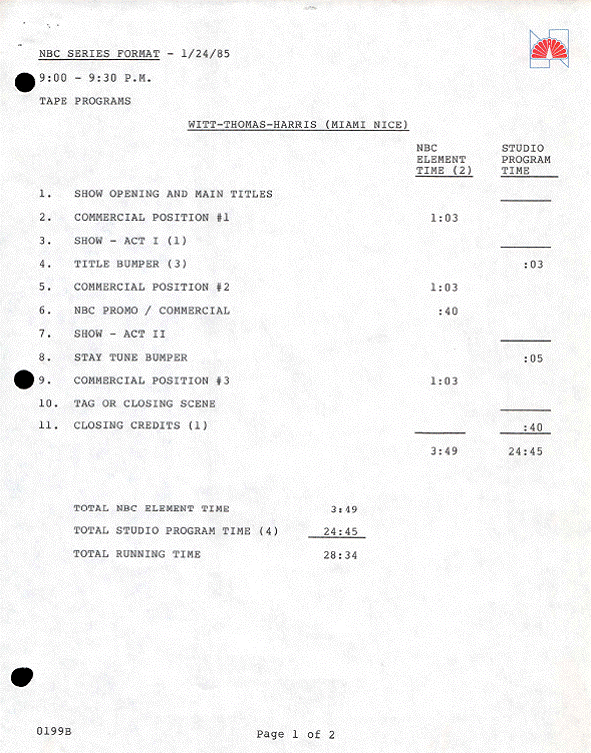>A friend of the site provided an interesting piece of television history, the original program format NBC issued to production company Witt-Thomas-Harris for a pilot tentatively titled Miami Nice. Of course, the pilot ultimately would premiere as The Golden Girls on September 14, 1985 with a 25.0 household rating and 43 share — an instant hit. On a Saturday night, no less. What’s really interesting is the program time allotted to this half hour comedy: almost 25 full minutes of program content. Specifically, 24:45 of program time and 5:15 of non-program time (3:49 of network commercials and promos and 1:15 of local time). And how many network commercials? Exactly, six 30-second spots. Three minutes total — three network commercial breaks, each one-minute long. (See the format by clicking “read more”.)
To put these numbers in context, we took a look at the program format for Wednesday’s Modern Family on ABC. Modern Family had a little over 21 minutes (21:15) to tell its story in a 31-minute time period (9:00-9:31 pm), leaving almost 10 minutes (9:45) of commercials, network promos, local spots and local news teases. Sadly, this is a very typical ratio of program to commercial time on network prime time today (about 2:1). Further, this non-program time was heavily back-loaded into the second half of the show. The first commercial break on Wednesday was actually shorter than the first commercial pod for the Golden Girls over 25 years ago (0:50 versus 1:03). But the second and third commercial pods in Modern Family ballooned to well over four minutes each: 4:35 for the second commercial position and 4:20 for the third pod, compared to 1:43 for the second pod in Golden Girls and back to 1:03 for the third break. So from about 9:00-9:13 pm, there was more than 12 minutes of program content. But from 9:13-9:31 there was roughly one minute of “junk” for every minute of programming (8:55 in commercials/ promos versus 8:40 program content).
Clearly, 1985 was a very different time. The broadcast networks still dominated the television landscape, although the wheels were already in motion to change that with the 1984 passage of the Cable Act by Congress. Around 1980, about 16 million households had cable, mostly as a rather quaint “community antenna” to serve areas with bad over-the-air reception. By the end of the decade, however, over 50 million households would have cable. Of course, the VCR and more significantly the DVR would follow, satellite TV would add to the competition, and the Internet ultimately would come, enabling streaming and “TV anywhere”.
But the paradox is that when the broadcast networks were fat and happy, they limited themselves to six commercial units per half hour, with only two commercials per break. Viewers had to basically sit there and watch the spots live, and the commercials could be effective in a very uncluttered environment. Now, with about half of the audience able to scan right past commercial messages with a DVR, the networks pour more commercial units into each break to maximize revenue in the short term while hammering another nail into the industry’s own eventual coffin. Would advertisers pay higher prices for reduced commercial clutter and potentially increased effectiveness? No one would line up to be the first to experiment. It would require a partnership between the networks who sell the time and the advertising agencies who buy the time to limit the supply of available commercial inventory. Such cooperation would raise eyebrows in Washington at the FCC and DOJ, and who wants to deal with two powerful but clueless government agencies? (Legislators and regulators are consistently 20-30 years behind the times in their assessment of the networks’ market power.) Easier for everyone to whistle past the graveyard where the tomb is being prepared.
###





